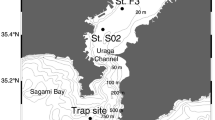Abstract
Sediment trap arrays were deployed at two deep ocean stations, one in the Bering Sea and the other in the Gulf of Alaska, in the summer of 1975. The sediment trap was constructed of a pair of polyethylene cylinders (0.185 m2 opening) with funnel-shaped bases. The trap is equipped with a lid which is closed before recovery by a tripping messenger system triggered by an electric time release. 37–68% of the total organic carbon fluxes (37–38% in the Bering Sea; 48–68% in the Gulf of Alaska) were represented by large particles (67µm<) such as fecal matter and fecal pellets which contributed minor fractions to the total particulate organic matter concentration in sea water. The total fluxes were 11.1 and 14.2 mg C m−2d−1 at 1,510 and 2,610 m respectively at the station (3,800 m) in the Bering Sea, and were 7.60, 4.66 and 3.27 mg C m−2d−1 at 900, 1,500 and 1,875 m respectively at the station (4,150 m) in the Gulf of Alaska. The former values are several times greater than the latter, suggesting that there is a regional variation in the vertical carbon flux in deep layers. The fluxes were approximately equivalent to 1 to 3% of primary productivity in the overlying surface layers. These observations suggest that deep-water ecosystems may be influenced by relatively rapid sinking of large particles such as fecal matter and fecal pellets from near surface production.
Similar content being viewed by others
References
Bishop, J.K.B., J.M. Edmond, D.R. Ketten, M.P. Bacon andW.B. Silker (1977): The chemistry, biology and vertical flux of particulate matter from the upper 400 m of the equatorial Atlantic Ocean. Deep-Sea Res.,24, 511–548.
Dal Pont, G. andB. Newell (1963): Suspended organic matter in the Tasman Sea. Aust. J. Mar. Freshwat. Res.,14, 155–165.
Deuser, W. G. andE. H. Ross (1980): Seasonal changes in the flux of organic carbon to the deep Sargasso Sea. Nature,283, 364–365.
Fowler, S. W. andL. F. Small (1972): Sinking rates of euphausiid fecal pellets. Limnol. Oceanogr.,17, 263–296.
Froelich, P.N. (1980): Analysis of organic carbon in marine sediments. Limnol. Oceanogr.,25, 562–572.
Gardner, W. D. (1977): Fluxes, dynamics and chemistry of particulate in the ocean. Ph. D. Thesis, Mass. Inst. Technol./Woods Hole Oceanogr. Inst., 405 pp.
Hattori, A. (Ed.) (1977): Preliminary report of the Hakuhô Maru Cruise KH-75-4, Ocean Research Institute, University of Tokyo, Tokyo, 87 pp.
Honjo, S. (1978): Sedimentation of materials in the Sargasso Sea at a 5,367 m deep station. J. Mar. Res.,36, 469–492.
Honjo, S. (1980): Material fluxes and mode of sedimentation in the mesopelagic and bathypelagic zones. J. Mar. Res.,38, 53–97.
Honjo, S. andM.R. Roman (1978): Marine copepod fecal pellets: production, preservation and sedimentation. J. Mar. Res.,36, 45–57.
Ichikawa, T. (1976): Particulate carbon and nitrogen in the Pacific Ocean and adjacent seas. Ph. D. Thesis, Tohoku Univ., 130 pp.
Iseki, K. (1977): A study of vertical transport system of particulate organic matter in the sea. Ph. D. Thesis, Tohoku Univ., 138 pp. (in Japanese)
Iseki, K. (1981): Particulate organic matter transport to the deep sea by salp fecal pellets. Mar. Ecol., Prog. Ser.,5, 55–60.
Iseki, K., F. Whitney, andC.S. Wong (1980): Biochemical changes of sedimented matter in sediment trap in shallow coastal waters. Bull. Plankt. Soc. Japan,27, 27–36.
Knauer, G.A., J.H. Martin andK.W. Bruland (1979): Fluxes of particulate carbon, nitrogen and phosphorous in the upper water column of the northeast Pacific. Deep-Sea Res.,26, 97–108.
Knauer, G.A. andJ.H. Martin (1981): Primary production and carbon-nitrogen fluxes in the upper 1,500 m of the northeast Pacific. Limnol. Oceanogr.,26, 181–186.
McAllister, C.D. (1969): Aspects of estimating zooplankton production from phytoplankton production. J. Fish. Res. Bd. Canada,26, 199–220.
McCave, I.N. (1975): Vertical flux of particles in the ocean. Deep-Sea Res.,22, 491–502.
Menzel, D.W. (1974): Primary productivity, dissolved and particulate organic matter, and the sites of oxidation of organic matter.In, The Sea, Vol. 5, ed.,E.D. Goldberg, Wiley New York, pp. 659–678.
Nakajima, K. (1973): Suspended particulate matter in the western north Pacific Ocean. Mem. Fac. Fish. Hokkaido Univ.,20, 1–106.
Rowe, G.T. andW.D. Gardner (1979): Sedimentation rates in the slope water of the north-east Atlantic Ocean measured directly with sediment traps. J. Mar. Res.,37, 581–600.
Shanks, A. L. andJ. D. Trent (1980): Marine snow: sinking rates and potential role in vertical flux. Deep-Sea Res.,27, 137–143.
Smayda, T.J. (1969): Some measurements of the sinking rate of fecal pellets. Limnol. Oceanogr.,14, 621–625.
Smayda, T.J. (1970): The suspension and sinking of phytoplankton in the sea. Oceanogr. Mar. Biol. Annu. Rev.,8, 353–414.
Spencer, D.W., P.G. Brewer, A. Fleer, S. Honjo, S. Krishnaswami andY. Nozaki (1978): Chemical fluxes from a sediment trap experiment in the deep Sargasso Sea. J. Mar. Res.,36, 493–523.
Staresinic, N., G. T. Rowe, D, Shaughnessey andA. J. Williams (1978): Measurement of the vertical flux of particulate organic matter with a free-drifting sediment trap. Limnol. Oceanogr.,23, 559–563.
Taniguchi, A. (1972): Geographical variation of primary production in the western Pacific Ocean and adjacent seas with reference to the inter-relations between various parameters of primary production. Mem. Fac. Fish. Hokkaido Univ.,19, 1–34.
Turner, J. T. (1977): Sinking rates of fecal pellets from the marine copepodPontella meadii. Mar. Biol.,32, 219–225.
Wangersky, P.J. (1974): Particulate organic carbon: sampling variability. Limnol. Oceanogr.,19, 980–984.
Wiebe, P., S. H. Boyd andC. Winget (1976): Particulate matter sinking to the deep sea floor at 2,000 m in the Tongue of the Ocean, Bahamas, with a description of a new sedimentation trap. J. Mar. Res.,34, 341–354.
Author information
Authors and Affiliations
Rights and permissions
About this article
Cite this article
Iseki, K. Vertical transport of particulate organic matter in the deep Bering Sea and gulf of Alaska. Journal of the Oceanographical Society of Japan 37, 101–110 (1981). https://doi.org/10.1007/BF02308094
Received:
Revised:
Accepted:
Issue Date:
DOI: https://doi.org/10.1007/BF02308094




